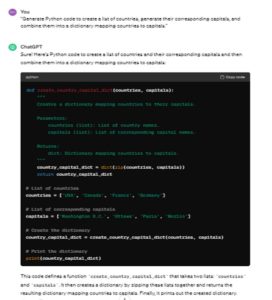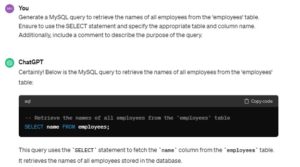Artificial Intelligence Certification Course
- 19k Enrolled Learners
- Weekend
- Live Class
Prompt engineering is the secret key in the world of technology, allowing the transformation of words into code by providing clear commands to AI. This skill is essential because it unlocks AI’s full potential, allowing for the seamless translation of ideas into tangible code. We’ll look at the fundamental principles of prompt engineering for code generation and synthesis, highlighting their key points. Discover the potential of prompt engineering and learn how to create prompts for code generation that simplify AI coding.
Prompt engineering is a process that creates specific prompts or instructions for AI language models to generate code snippets or scripts. It involves defining objectives, using relevant keywords, providing examples, being specific and concise, and encouraging creativity. This process enhances the accuracy, efficiency, and relevance of code generation tasks performed by AI models. Understanding how to prompt LLMs can lead to more powerful and efficient applications.
Begin your journey to becoming a prompt engineer with our comprehensive guide and prompt engineering tutorial – uncover the essential steps and skills needed for success.
Generative AI mimics human creativity by generating text, images, and music. A generative AI certification provides hands-on training to develop AI models, making professionals industry-ready for roles in automation, tech, and content generation.
GitHub Copilot: Based on given prompts, GitHub Copilot suggests completions, creates documentation, and suggests new features to help developers write code. This is achieved by utilizing prompt engineering.
Google AI Code-Da Vinci: Code-Da Vinci helps developers write code in a variety of programming languages by using prompt engineering. By producing code snippets in line with predefined prompts, it facilitates a variety of tasks, from web development to natural language processing and machine learning.
Open AI Codex: Codex assists developers with coding tasks in a variety of domains, such as data science, web development, and game development, by utilizing prompt engineering. It creates code in a number of programming languages based on the precise instructions that users provide.
Prompt engineering is crucial for guiding AI models in generating code accurately.
Let’s explore practical examples across different complexity levels.
Basic example:
Topic: “Sum of Two Numbers”
Prompt: “Generate a function in Python that takes two numbers as input and returns their sum.”
Topic: “Hello World Program”
Prompt: “Generate a ‘Hello, World!’ program in Java.”

Now that we’ve seen how easy level tasks work, let’s move on to medium level examples.
Turn Comments Into Code
“Generate Python code to create a list of countries, generate their corresponding capitals, and combine them into a dictionary mapping countries to capitals.”

Complete Functions or Next Line
def calculate_rectangle_area():
Write a Python function named calculate_rectangle_area that takes two parameters, length and width, and returns the area of a rectangle. Include comments to explain each step of the function.

MySQL Query Generation
SELECT name FROM employees;
Generate a MySQL query to retrieve the names of all employees from the ’employees’ table. Ensure to use the SELECT statement and specify the appropriate table and column name. Additionally, include a comment to describe the purpose of the query.

Provide a line-by-line explanation of the Python function named calculate_factorial, which takes a parameter n and returns the factorial of n. Ensure to include comments explaining the purpose and operation of each line of code within the function


Prompt code generation engineering is a combination of art and science. Developers can successfully guide PLMs such as Codex to produce accurate code outputs by iteratively refining prompts and experimenting with different strategies. Learning and mastering Prompt Engineer Training allows developers to fully utilize PLMs in a variety of applications, making it an essential skill in the age of AI-driven software development.
Step into the future of AI by mastering prompt engineering. Develop the skills to create and optimize AI-driven interactions and unlock exciting Prompt engineering job opportunities in this cutting-edge field.
Got a question for us? Please mention it in the comments section and we will get back to you.
Related Posts:
 Thank you for registering Join Edureka Meetup community for 100+ Free Webinars each month JOIN MEETUP GROUP
Thank you for registering Join Edureka Meetup community for 100+ Free Webinars each month JOIN MEETUP GROUPedureka.co